The DS4G Test Diaries: Week 2 (by Christina Bramanti)
Monday, 8th May 2006
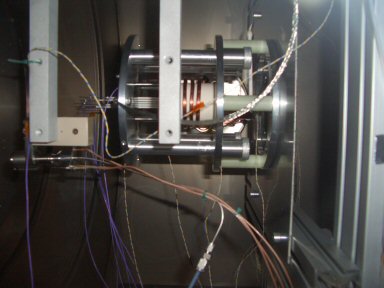
Today at the lab, we tried to get some plasma in this configuration. In this first phase of the experimental tests, five Langmuir probes are inserted in the screen grid and we are trying to characterise the plasma density in the source tube as a function of the RF power and the mass flow rate, by the varying these operating parameters.
As we do not apply any voltage on the grids, the start-up of the plasma by tuning the radio frequency power supply proved to be difficult. We tried different RF tuning but the plasma didn't appear. So we vent the CORONA hatch and checked if there was some leakage on the gas line. Everything seemed fine. We though that the help of a neutraliser was the right strategy at this stage, in order to attract some electrons inside the source tube and start up the avalanche. We mount the neutraliser and we made the vacuum again in the CORONA hatch.
Tomorrow is another day...
Tuesday 9th May 2006
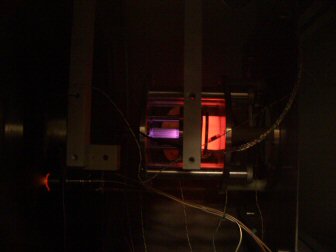
The neutralizer helped and the strategy was correct. We obtain plasma and we were able to run the first experiments. We were very happy. The colours are amazing. They vary according to the radio frequency power applied.
It is a very beautiful sight to the eyes...
Wednesday 10th May 2006
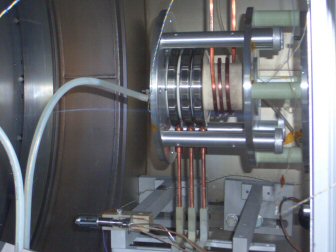
Today we worked the whole day at Corona test facility. We dismounted the DS4G thruster, used for the first phase of the experimental campaign, and we set up the second phase of the experimental campaign (the most important one!!!).
We mount the thruster with the new grids, specifically designed, in this second run of the tests, to improve the performance and the overall efficiency, and we connected all the electrical and high voltage interfaces inside the Corona.
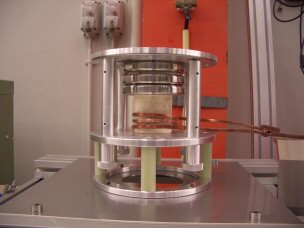
We performed a breakdown test at atmospheric pressure and we saw no arching at 10V. We check the feeding line to detect possible leakage and everything looked fine. At the end of the day we were very satisfied.
We closed up and pump down the CORONA hatch again.
Tomorrow the first high voltage tests....
Thursday 11th May 2006
Today at the CORONA test facility we started the day with some preliminary tests to characterise the dependency of the mass flow rate with the pressure inside the CORONA hatch and to evaluate the time response of the isolator, which was introduced in this second phase of the test campaign in order to avoid voltage breakdown. The isolator led to a very good improvement on the time response allowing to reach mass flow stable conditions in less time.
We performed other breakdown tests in vacuum for assessing the onset of arching events.
In the late afternoon we were ready to start the beam tests. The first ones in this very packing configuration with 61 holes in 2 cm. From now on the main goal is to find an operating point which minimises the ion impingement on the electrodes and extract. The variable parameters are the mass flow, the RF power tuning, screen grid electrode potential and the extraction potential between the screen grid and the second grid which defines the curvature of the ion beam through the electrodes.
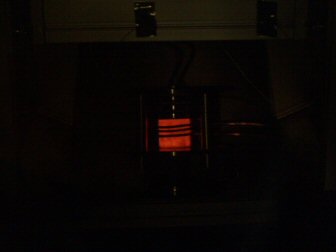
We ignited the plasma and started to tune and focus at 15 kV applied on the screen grid.
FIRST BEAM EXTRACTED!!!
We were able to sustain it just for 15 sec, but we were able to extract 14mA at 10kV and at 90W RF power.
Unfortunately, the success was short-lived for other runs just for few seconds before the plasma discharge ceased. So, we weren't able to optimise the ion optics to reduce impingement on the grids. As always, we have a lot of trouble shooting and test runs, diagnosis etc to do, but for now the team is very pleased with today's achievements.
Friday, 12th May 2006
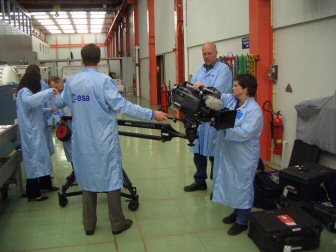
Today we had visitors at the CORONA test facility. The broadcast ''Beyond Tomorrow'' from Australia. The team visited us to film a special about our experiments. We will watch it on Discovery Channel World!
They remained with us for the whole day in order to take enough material and transform it in an interesting special.
We went on with our work and they were looking forward to watch and film the beam.